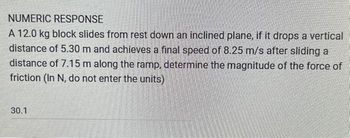Question

Transcribed Image Text:NUMERIC RESPONSE
A 12.0 kg block slides from rest down an inclined plane, if it drops a vertical
distance of 5.30 m and achieves a final speed of 8.25 m/s after sliding a
distance of 7.15 m along the ramp, determine the magnitude of the force of
friction (In N, do not enter the units)
30.1
Expert Solution
This question has been solved!
Explore an expertly crafted, step-by-step solution for a thorough understanding of key concepts.
Step by stepSolved in 3 steps with 1 images

Knowledge Booster
Similar questions
- UD MY UTEP ← → C User Settings X Document Sharing A Mail-Alvarado, X mylabmastering.pearson.com/?courseld=12473856&key=14018101051816159781032023#/ Two packages at UPS start sliding down the 20.0° ramp shown in (Figure 1). Package A has a mass of 2.00 kg and a coefficient of kinetic friction of 0.350. Package B has a mass of 10.0 kg and a coefficient of kinetic friction of 0.110. Type here to search Blackboard Learr x PCourse Home X ℗ 7.3.3: A Strategy × b Answered: Two * G Two packages at x + For help with math skills, you may want to review: Vector Components Figure B A 1 of 1 2.00 m 20.0° W How long does it take package A to reach the bottom? Express your answer with the appropriate units. ► View Available Hint(s) At = Submit 0 Provide Feedback μA Value Units ? 74°F Sunny G✩ 4) 0 Next > 5:55 PM 11/3/2023 D x :arrow_forwardResources %= LG An average froghopper insect has a mass of 11.5 mg and reaches a maximum height of 298 mm when its takeoff angle is 57.0" above the horizontal. What is the takeoff speed up of the froghopper? m/s Carrow_forwardA 124 kg crate is pushed at constant speed up a frictionless inclined plane of θ = 48 ° with the horizontal. Assuming one pushes with a horizontal force, what is the magnitude of the force F (in N) required to do this?arrow_forward
- An object is sliding across a frictionless surface at a velocity of 2.40 m/s toward the origin. When it is 6.0 m from the origin, it suddenly experiences an acceleration of -1.60 m / s. If the acceleration remains constant, what will its distance from the origin be when its velocity reaches -12.0 m/s? -80.65 m -37.2 m -40.43 m -16.40 m Next Page Page 6 of 10arrow_forwardWith no losses in the string-pulley system, calculate the force. Help please?arrow_forwardA 60 kg skier starts from rest at a height H = 33 m above the end of a ski jump ramp. If the skier leaves the ramp at an angle of θ = 25º, determine the maximum height h the skier will reach.arrow_forward
arrow_back_ios
arrow_forward_ios